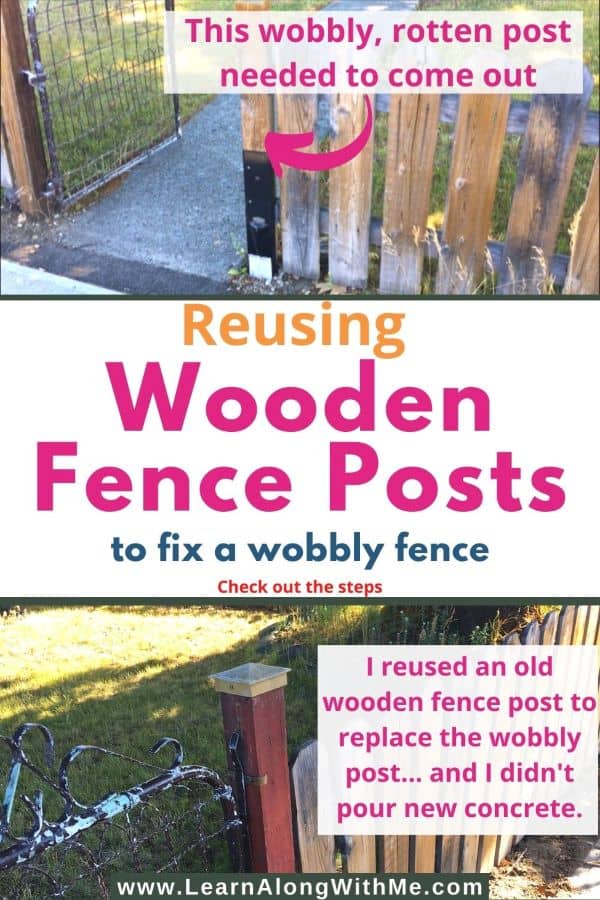I hated the messy look of our holly tree, and the large rocks underneath the tree trapped fallen leaves. They were very hard to clean up. I needed to know what to put under a holly tree to make leaf clean-up easier.
I made a choice and tackled this front yard landscaping project.

This article contains affiliate links. If you click a link and buy something I may receive a small commission at no extra cost to you. As an Amazon Associate I earn from qualifying purchases. For more information please see the Disclosure page.
My Main Goal of this Holly Tree Landscaping Project
My main goal for this project was to put a different landscaping material under my holly tree so that it would be easy and quick to clean up fallen leaves: both holly leaves and maple leaves from a nearby maple. The holly tree is not deciduous, but it still drops some leaves. (Which isn’t a surprise because there are so darn many of them.)
The large landscaping rocks that were under there trapped the leaves and made clean up very difficult.

It was hard to get a rake in between the stones to scrape up the leaves, and a leaf blower didn’t work well either. I needed to get rid of those big rocks.

I needed a more uniform, flatter surface so that I could blow the leaves right off. And since I’d be using a leaf blower, the material I put under the tree would have to be big enough to not be blown away too.
I chose a 1” decorative rock that the landscape supplier called “Blue Stone”.
In this article I’ll describe how the project went from research to completion.
Would you like to see the video of me doing this project? Click below.
What is the best mulch for holly trees?
According to several online resources, holly loves acidic soil so it can benefit from organic mulch like pine needles or peat moss. (Resource 1 & 2).
I avoided these natural mulches though because remember, my main goal of this project is to find a landscaping material to put under the tree that will make leaf cleanup quick and easy.
I think pine needles just look like more debris. (And I want to avoid dry, ignitable debris on my yard if possible since the fire risk around here keeps increasing.)
And using a leaf blower on the pine needles or peat moss will likely just blow them away too.
So I narrowed it down to wanting some rocks under the tree.
Some other landscaping sites say to avoid rock as mulch around trees because they don’t fertilize the trees and the rocks may absorb heat from the sun and damage the tree roots. Plus, they said rocks can get onto the lawn and dull the lawn mower blade.
My thoughts on this are that since the tree already had rocks around the base and the tree is thriving I’m not too worried about that. Plus, the tree is on the north side of my house out of direct sunlight. And I don’t plan on having grass anywhere near the tree so I’m not concerned about that.
(I’m slightly more concerned about the prune job I did than the rocks I ultimately put down.)
And if the tree starts to suffer due to the rocks making the soil alkaline, I can use coffee grounds to acidify the soil. (Care of this reference.)
What to put under a holly tree – the steps I took in this DIY landscaping project
Step 1 – Trim the bottom branches

First I needed to trim the bottom branches of the holly tree so that I could get underneath it to remove the large rocks.
And according to our province’s “FireSmart” program, removing the bottom branches is supposed to help reduce the fire risk of our landscaping by eliminating “fuel ladders.”
(But that same program – intended to help reduce the risk of wildfire setting a house on fire – says that holly is not a good tree to have in your yard anyway. I am not going to cut the tree down at this time, but I did trim the branches to about 5.5-feet off the ground.)
Holly leaves are sharp and pokey so I had to wear a thick jean jacket while pruning.
I used my handheld pruners and an electric chainsaw for some of the larger branches.
Step 2 – Remove the large rocks and leaf debris

Once the bottom branches were removed I was able to start moving the large rocks from under the tree.
I wish I would have trimmed the branches up slightly higher so that I could stand up straight under the canopy of the branches without having to hunch over.
Moving these heavy rocks took quite a long time. Part of the problem was figuring out where the heck to put the rocks.
I had brought the rocks in several years ago and “just in case” I wanted to use them again somewhere else, I decided to just move the rocks off to the side beside my house.
Having rocks or other non-combustible material against the side of your house is also recommended by that FireSmart program.
After I moved all the big rocks off to the side I was able to rake up the piles of leaves and organic debris that had accumulated over the years.
Step 3 – Remove the old landscaping fabric and install new lawn edging

There was black landscaping fabric under the large rocks. It did a good job of suppressing weeds, but I suspect that may have been due more so to the thick holly branches blocking out the sunlight under its canopy, and less about the fabric.
But anyway, I moved the old landscaping fabric to the side.
I had some 4-inch plastic lawn edging at my house that was left here from the previous owner. This plastic edging is sold in rolled bundles and tends to maintain that curled shape.
So to straighten and flatten it, I set it out in the sun to warm up.
Then I placed the edging on the ground around the tree in a semi-circular fashion. The edging butts up against some existing lawn edging along the back side of the tree.

I didn’t get too fancy with measuring. I eyed it up and moved it around until I thought it looked good.
Then I used a spade shovel to mark the ground right beside where the edging would be installed.
I dug out a trench for the edging using the spade shovel and small garden shovel.
I discovered that lawn edging that needs to be buried may not be the best choice for edging around a tree: especially a tree with shallow roots.

I didn’t want to cut the tree roots. So…
I ended up marking the edging with a permanent marker then used tin snips to cut the plastic edging so that it would straddle the tree roots. (As shown below.)

Once I had the edging all trimmed to fit around the roots I placed it into the trench, backfilled it and tamped down the soil so that it was secure.
Step 4 – Lay down gravel rock crush and landscaping fabric

I actually made some mistakes during this step.
The mistake I made is that I put the landscaping down onto the exposed ground and then put the gravel rock crush layer on top of the fabric.
The worker at the landscaping company told me I should have put the gravel down first and put the black landscaping fabric on top of the gravel then a decorative layer on top.
She said the weed barrier is always supposed to go right underneath the decorative top layer…and not under the gravel base layer.
By the time I learned this I had already “made the mistake.” I didn’t want to remove the gravel and do this step over again, so I’ve chalked it up to a learning lesson. I am curious if more weeds will grow now because they grow in the bits of dirt contained in the rock crush layer. (Called 3/4″ minus road crush.)
The other mistake I made isn’t a big deal, but it involves getting free landscaping supplies. I picked up some “free decorative rocks” on Facebook marketplace but the rocks weren’t usable as a decorative top layer. It was more like gravel or 3/4″ minus road crush. Which is fine because I used it as the base layer instead of the top layer.
I shoveled this gravel into the area under the tree, used a rake to spread it and then tamped it down with a log.
It was ready for me to pick some nice rocks to put on top.
Step 5 – Put the decorative rocks on top
Before I chose the decorative rocks to put on top, I had to review what the goal of this project was.
I wanted something under the tree that would make it easy and quick to clean up fallen leaves.
This meant what I put under the holly tree would have to be:
- fairly uniform in size to provide a relatively flat surface
- be large enough that they wouldn’t be blown away by the leaf blower
A lady at the landscaping supplier said they have 3/4″ rocks under a tree at their home and they get sucked up into the leaf blower when using the vacuum function.
I don’t think my leaf blower even has this feature so I’m not worried about sucking up rocks, but that concerned me about that size of rocks. Perhaps 3/4″ rocks would be too small.
So I decided to go with 1″ rocks called Blue stone.
They are not round, more of a fractured appearance so they settle in together and form a nice layer.

I got 1/4 yard of the rocks and then shoveled it on top of the gravel base layer.
Step 6 – Test the rocks with my leaf blower

I’m a bit biased, but I think the new rock mulch under our holly tree looks awesome. Well, it sure looks better than it did before!
But looks wasn’t all I was going for.
I needed functionality! I needed something that would make it easy to clean up fallen leaves.
So I had to put the new rocks to the test.
I dumped a bucket of leaves onto the rocks. It was holly leaves and maple leaves. (My neighbors probably thought I was crazy.)
Then I grabbed my leaf blower and blasted the leaves.
To my delight and amusement the leaves went airborne and blew off the new 1″ rocks.
Did it get each and every leaf off?
No, there were still some pokey little holly leaves that stayed behind but WAY BETTER than the large boulders had been.
I am going to put this one in the win column. I think it looks better and it’ll be easier to clean up the leaves in the fall.
Thank you for checking out my article on what to put under a holly tree. I think the 1″ stones I put under the holly tree look better and will make leaf clean-up easier.
I learned that plastic lawn edging may not be the best choice to put around a tree with shallow roots, but I was able to trim the edging to make it work.
I also learned that black fabric weed barrier should go directly under the top decorative layer and not the base layer.
I know I still have lots of work yet to do in my front yard, but I’m happy with this start.
One of my future projects will be redoing my front walkway. Below is an article where I’ve researched some potential front yard walkway ideas. I haven’t committed to one yet, but check it out if you too are interested in the different ideas.

Thank you.
Tim from LearnAlongWithMe.com
Tim worked in construction for a few years before going to university. Then he worked as a community pharmacist for 10 years and now works as a full-time writer and online publisher. He has experience in several different, far-reaching lines of work.
“I sincerely hope you find the articles helpful and informative.”
Tim from LearnAlongWithMe.com





